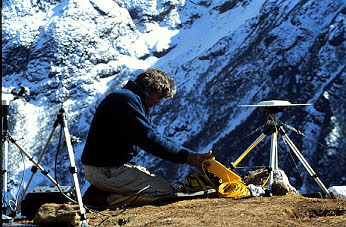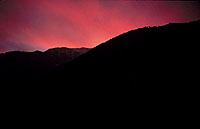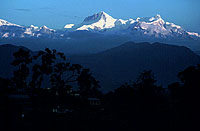
|
 |
 |
 World's Highest Weather Station
World's Highest Weather Stationpart 3 | back to part 2 NOVA: Who will be able to access the information from this site? BILHAM: Well, supposing we get the link between Everest and Kathmandu established, anyone in the world should be able to pick up the data. It is stored on the system's data logger and I should be able to call up the data logger with software loaded in my PC. Exactly how we make that data available to the public has not been determined yet, but we are hoping to put it on the internet for public use. NOVA: What will it be useful for? BILHAM: The unique thing about a weather station on Everest is that it's a very tall mountain of course, but it is a divide, it's a mountain which is in a boundary between dry conditions over Tibet and very wet conditions south of here—monsoon conditions sometimes. People are beginning to realize that the Tibetan plateau drives most of the world's weather systems.  It's a huge, high plateau and in the summer it heats up and
sucks in air from all over Asia, and in particlar it sucks in
moist air from the Indian Ocean and that brings with it a
tremendous rainfall potential which dumps on the southern edge
of the Himalayas, and in so doing washes away vast quantities
of sediment into the oceans. In fact, a quarter of all the
world's sedimentary deposits are being washed into the Indian
Ocean from this monsoon condition that happens every year. The
monsoons carve their mark yearly on the Himalayas as they push
sediments from the mountains down to the Ganges,the
Brahmaputra, and the Indus rivers. (See our NOVA program in
December '96 about the Himalaya's effect on weather.) It's a huge, high plateau and in the summer it heats up and
sucks in air from all over Asia, and in particlar it sucks in
moist air from the Indian Ocean and that brings with it a
tremendous rainfall potential which dumps on the southern edge
of the Himalayas, and in so doing washes away vast quantities
of sediment into the oceans. In fact, a quarter of all the
world's sedimentary deposits are being washed into the Indian
Ocean from this monsoon condition that happens every year. The
monsoons carve their mark yearly on the Himalayas as they push
sediments from the mountains down to the Ganges,the
Brahmaputra, and the Indus rivers. (See our NOVA program in
December '96 about the Himalaya's effect on weather.)Click here to hear Roger talk about the monsoon. NOVA: Will the weather station be useful in helping predict storms on Everest for expeditions attempting its summit?  BILHAM: The data will certainly help, but the weather
station will tell us only about the weather actually occurring
that day (or minute) on Everest. It is up to us to interpret
these data, together with data from all over Asia, if we are
to predict changes in future weather in the Everest region.
BILHAM: The data will certainly help, but the weather
station will tell us only about the weather actually occurring
that day (or minute) on Everest. It is up to us to interpret
these data, together with data from all over Asia, if we are
to predict changes in future weather in the Everest region.Sensors being used on the station include type K thermocouples, a special thermistor from Yellow Springs Instruments, a wind sensor from RM Young Inc., designed for high wind speed, and a solar radiation sensor from Licor. Photos: (1) Liesl Clark; (2-3) courtesy David Breashears. Lost on Everest | High Exposure | Climb | History & Culture | Earth, Wind, & Ice E-mail | Previous Expeditions | Resources | Site Map | Everest Home Editor's Picks | Previous Sites | Join Us/E-mail | TV/Web Schedule About NOVA | Teachers | Site Map | Shop | Jobs | Search | To print PBS Online | NOVA Online | WGBH © | Updated November 2000 |